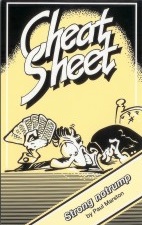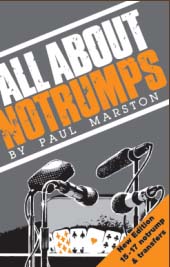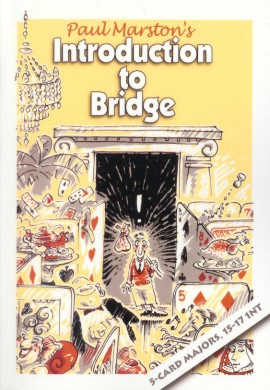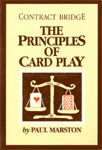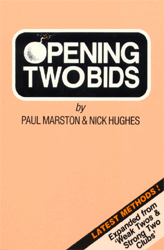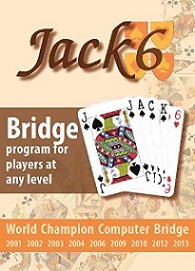Books |
Books in cart:
View/Edit Cart
|
The Language of Bidding - 2 over 1
The Language of Bidding - 2 over 1
by Paul Marston
This book covers all aspects of bidding, based on the Two over One system. There are several different versions of Two over One in common use, some of them quite flawed. Where there is genuine choice of approach, the author has chosen the more natural and consistent approach. The material is divided into 17 chapters, each one with a quiz. It is 210 pages in length. The Language of Bidding - Standard and Acol
The Language of Bidding
by Paul Marston
To win at bridge you have to be a skillful bidder. Good card play may be an asset but most hands are won or lost before a single card is played. The Language of Bidding shows you how to bid well. You have to know these things to be a good bridge player. The system is Standard with weak twos (the most widely used method in the world). It covers both four and five card majors. When you would choose a different bid depending on which of the two you are playing, the alternatives are noted. There are three sections: the first nine chapters cover uncontested auctions, the next four cover competitive auctions and the last two cover tournament play. The best way to learn a new skill is to try it out; this book gives you three great ways to do this. Each of the thirteen chapters has a quiz. They also have four practice hands for you to play. (You can make them up from strips in the back of the book.) The hands illustrate the bidding and they contain card play pointers. On top of this, chapters two to thirteen each have twelve bidding practice hands. You turn to one page while your partner turns to another. Then you can compare your auctions with my recommendations. While you have to learn quite a few things before you can be considered to be an expert bidder, the process of finding out is both fulfilling and fun.
Winning Decisions in Competitive Bidding
Winning Decisions in Competitive Bidding
by Paul Marston
The foreword to the book is by Jean-Rene Vernes, the man who discovered the Law of Total Tricks. He said... "An analysis of World Championships shows that the opponents overcall the opening bid on about half the hands. This means it is not enough to have a good bidding system. We also have to know how to bid in competitive auctions. The common practice after an opposing overcall was to bid to a contract we thought we could make. We might also overbid by a trick or two as a sacrifice. This is a common problem. South holds:
and the bidding starts like this:
South bids 3S, hoping that either it will make or that East-West would have made their 3H. Thinking about it, this reasoning has a clear fault: How do we know that East-West will indeed make 3H? Maybe East bid 3H to avoid North-South making 2S. Clearly if both 3H & 3S fail, then South should pass 3H. In this form the problem seems insoluble because we are never sure whether the opponents will make their contract or not. While I was reflecting on this problem in the 50s, I discovered a fundamental law of bidding which indirectly resolves the problem. There is a way to work out the total number of tricks that would be won by North-South if they played in spades and by East-West if they played in hearts. This number is generally equal to the total number of trumps helf by North-South in spades and East-West in hearts. This is what I named the Law of Total Tricks. In our example, if we assume that each side has an eight card fir then there are just 16 total tricks available. We should clearly pass 3H, expecting that either 3H or 3S will fail. This Law teaches us to look at auctions in a totally different way. There are many applications of the Law. Paul Marston's presentation is both intelligent and clear. I'm convinced that this book will be of considerable benefit to players who take the time to study it." Jean-René Vernes, August 1995 Cheat Sheet
Cheat Sheet
by Paul Marston
HOW TO USE YOUR CHEAT SHEET
LIMITATIONS OF YOUR CHEAT SHEET
All About Notrumps
All About Notrumps
by Paul Marston
Notrump calls make bidding easy and logical because they have precise meaning. Unlike suit bids, all notrump calls limit the hand within two or three points which simplifies the responder's task of deciding whether to go to game, possibly slam. You cannot get ahead until you understand this structure. Playing in notrumps is also satisfying. It is usually a race between the declarer and the defenders to set up tricks. Making the contract means winning the race. Good play and defence in notrumps calls for an understanding of the different ways that you can take tricks and an awareness of timing, but many players don't have these skills. How often have you heard the desperate gasp: "I hate playing notrumps"? For these players, notrumps is a time of tension instead of the rewarding adventure that it should be. This books aims to put all that right. You will learn about the structure of notrump bidding and the essential priciples of notrump play. After reading this book, you will know when to bid notrumps. What's more, you will relish the oppotunity to do so. Chapter one deals with notrump opening bids; chapter two covers responding to notrump bids on balanced hands; chapter three, responding on unbalanced hands; chapter four explains when a notrump bid is a description of the hand and when it's a choice of contract, an important difference that causes much confusion; and chapter five deals with the Stayman convention. Each chapter has two card play tips: one for the declarer and another for the defenders. These are then illustrated in the four play hands at the end of each chapter. For bulk orders please contact us at books@grandslam.com.au |
Introduction to Bridge
Introduction to Bridge
by Paul Marston
You have made a fine decision in taking up bridge. Amongst other things, you can expect the game to sharpen your mind and broaden your circle of friends. You will find it easy to learn, despite what you might have heard. There is not a lot to memorise - it is more a matter of getting a feel for the game. By the end of the book you can expect to be playing a sound basic game of bridge, even if you have never played cards before. This is not to say that you will know it all - there's always something new to learn at bridge. But you will be ready to take your place in the bridge world and that is something to really look forward to. The Principles of Card Play
The Principles of Card Play
by Paul Marston
This book covers the elements of card play. It assumes that you have played a little bridge, enough to know how the game works. So far you may have concentrated on your bidding but now you would like to play the cards well, both as declarer and defender. What a good position to be in! For a reasonable amount of effort you can directly improve your results. While each hand may occur as infrequently as Halley's Comet, most hands can be categorized and you will see the same old problems time after time. This means that you can be a successful card player without having a computer brain; you do not have to memorize endless figures. Just learn how to use a short list of principles and you will be well on the way. Five percent of the hands may be complex but the rest are not. This book shows you how to play well on the straightforward ninety-five percent of the hands. It reveals the principles that constantly recur, then it demonstrates by example how you can take advantage of them. Most of the examples are "step by step". That is, you are asked questions and given the answers as you play through the hands. Do take the trouble to work out your own answers. It is more effective if you work them out for yourself. I have watched many players go through the process of acquiring these skills, and no-one has had to concede defeat. Admittedly it sometimes takes an effort, but they think it was well worthwhile. It will surely be the same for you. By the end of the book you will play with confidence and purpose. You will take more tricks both in play and defence.
Making the best use of this book You may also like to set up the problems with real cards. Although this takes extra time, do it if it helps. At the back of the book there is a glossary, an index, and seventy-five practice hands. The hands listed in the back are the complete layouts of the example hands and exercises. Each player's hand is listed on a separate page so you can make them up without peeking, then play them. They are organised so that you will succeed if you make the proper play. Do not plan to read too much in one sitting. Many ideas will be new so you will probably need time to digest them. It is a good idea to re-read the book in a few months. You will no doubt be surprised at how easy the problems seem the second time around. Opening Two Bids
Opening Two Bids
by Paul Marston & Nick Hughes
These days there is only one way to play your opening two bids: 2C for strong hands and 2D/H/S for shapely hands of below opening strength. By using 2C for all your strong hands you keep the other bids free for attack. Now you can hit them with weak twos or multi twos. The first two chapters are on weak twos and the strong 2C. Weak twos are the most widely played twobid structure in the world. The reasons are not hard to find. They are logical. If it makes sense to open three with 6-10 HCP and a seven card suit, doesn't it make sense to open two with a six card suit? Being logical, they are easy to use. Even beginners can expect to use them properly by simply reading chapter one. And they are effective. When you open with a weak two you put your side in control.
Chapter three is about multi twos. Multi twos, a variation on the weak two theme, have become standard fare for experts. All 48 pairs that made the quarter finals in the 1991 Bermuda Bowl in Yokohama used multi twos in one form or another along with a strong two clubs (except a couple of strong club pairs). No-one used 2D/H or S as a strong bid. You won't get a clearer vote than that. With all this destructive weaponry out there, it makes sense to give some thought to defending yourself. Chapter Four shows you an effective way to fight back. All the chapters have quizzes. The first wo chapters also have practice hands with make-up strips, making them the ideal for a partnership that is upgrading methods or a teacher giving classes. Jack
|
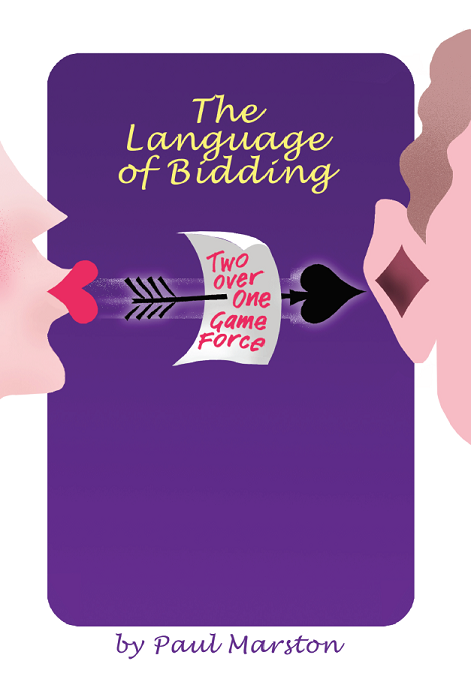
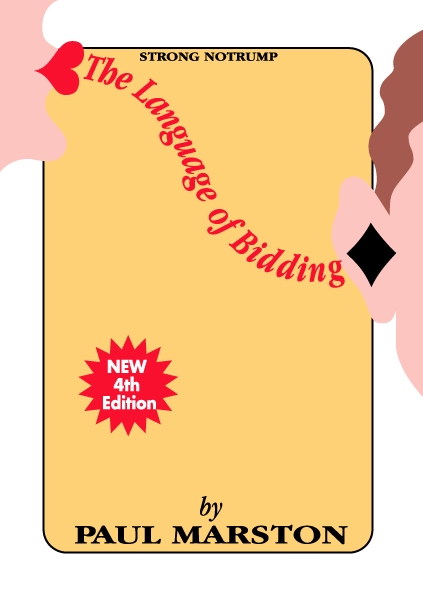
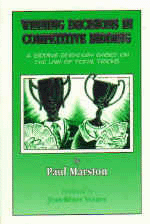
 KJ842
KJ842 J86
J86 AQ5
AQ5 A3
A3